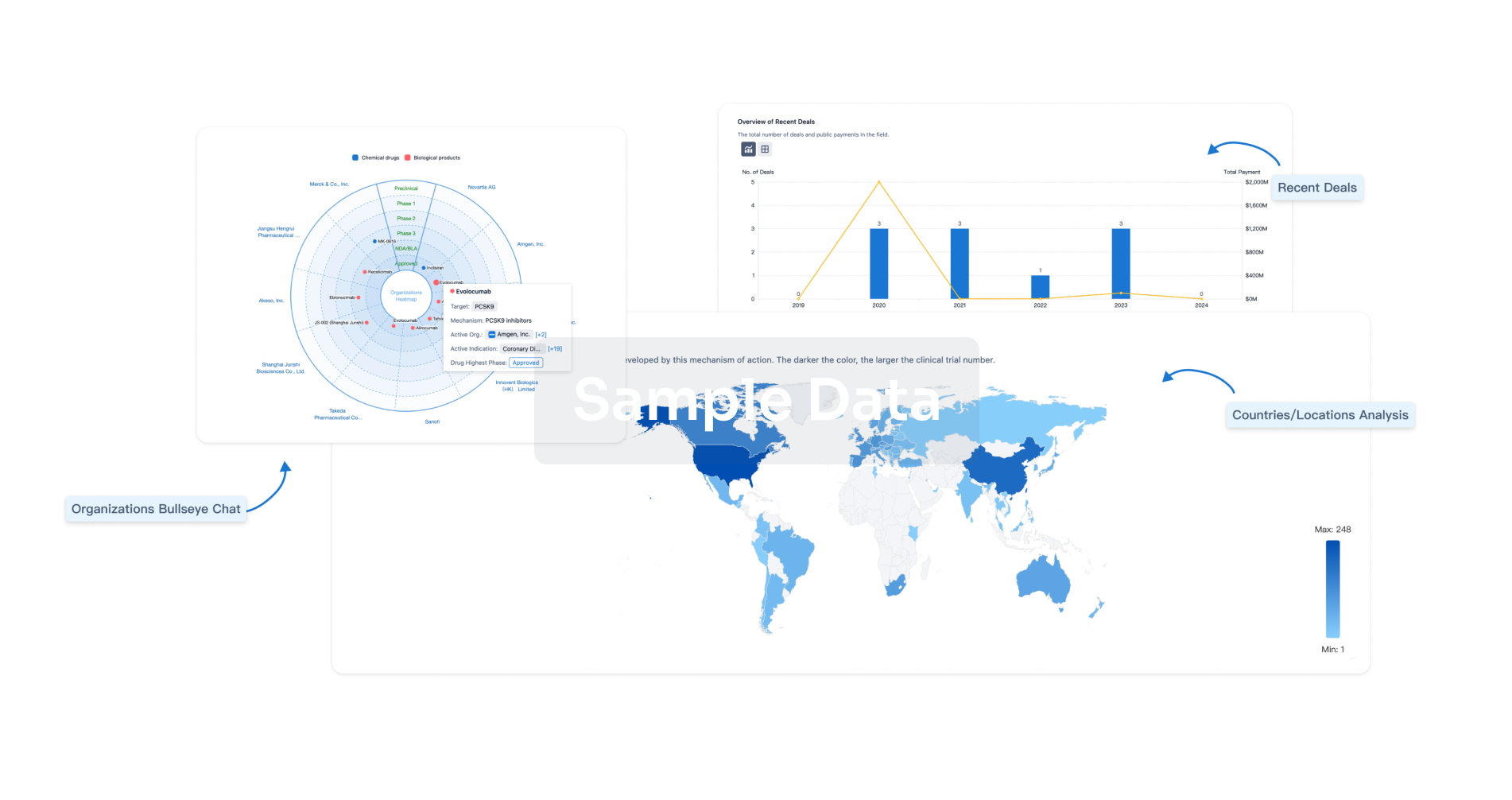Request Demo
Last update 08 May 2025
5-HT1A receptor x 5-HT2C receptor x D2 receptor
Last update 08 May 2025
Basic Info
Related Targets |
Related
2
Drugs associated with 5-HT1A receptor x 5-HT2C receptor x D2 receptorMechanism 5-HT1A receptor agonists [+4] |
Active Org. |
Originator Org. |
Active Indication |
Inactive Indication |
Drug Highest PhaseApproved |
First Approval Ctry. / Loc.- |
First Approval Date20 Jan 1800 |
Mechanism 5-HT1A receptor agonists [+2] |
Active Org.- |
Originator Org. |
Active Indication- |
Inactive Indication |
Drug Highest PhaseDiscontinued |
First Approval Ctry. / Loc.- |
First Approval Date20 Jan 1800 |
6
Clinical Trials associated with 5-HT1A receptor x 5-HT2C receptor x D2 receptorEUCTR2012-001675-37-AT
A Prospective, Open-label, Exploratory Study to Investigate the Safety, Efficacy, and Haemodynamics of Lisuride Subcutaneous Infusion as Add-on to Conventional Treatment in Patients with Pulmonary Arterial Hypertension - Lis-Safe
Start Date07 Aug 2012 |
Sponsor / Collaborator |
NCT00408915
Double-blind, Placebo-controlled, Randomized, Multicentre Phase II/III Study to Evaluate the Efficacy and Safety of Lisuride, Applied Subcutaneously by Means of a Minipump in Patients With Advanced Parkinson's Disease Refractory to Conventional Oral Therapy
The aim of the study is to evaluate the long-term efficacy, local tolerability and safety of Lisuride applied as subcutaneous infusion compared to placebo in patients with advanced Parkinson's disease with motor fluctuations and "OFF" periods refractory to conventional treatment.
Start Date01 Jul 2006 |
Sponsor / Collaborator |
EUCTR2004-001589-42-AT
Transdermal lisuride:Phase II/III study (efficacy and tolerance) of transdermal lisuride (patches) in patients with Restless Legs Syndrome (RLS)
Start Date25 Dec 2004 |
Sponsor / Collaborator- |
100 Clinical Results associated with 5-HT1A receptor x 5-HT2C receptor x D2 receptor
Login to view more data
100 Translational Medicine associated with 5-HT1A receptor x 5-HT2C receptor x D2 receptor
Login to view more data
0 Patents (Medical) associated with 5-HT1A receptor x 5-HT2C receptor x D2 receptor
Login to view more data
33
Literatures (Medical) associated with 5-HT1A receptor x 5-HT2C receptor x D2 receptor03 Dec 2024·Clinical Practice & Epidemiology in Mental Health
Pharmacogenetic Testing in Treatment-resistant Panic Disorder: a Preliminary Analysis
Article
Author: Nardi, Antonio Egidio ; Zugliani, Morena Mourao ; Gomez, Manuella Assad ; do Cabo, Mariana Costa ; Martins, Renan Machado ; Fidry, Marcos ; Freire, Rafael C ; Faria, Clara Gitahy Falcão
01 Apr 2018·International Journal of NeuropsychopharmacologyQ2 · MEDICINE
The in Vitro Actions of Loxapine on Dopaminergic and Serotonergic Receptors. Time to Consider Atypical Classification of This Antipsychotic Drug?
Q2 · MEDICINE
ArticleOA
Author: Ouzid, Mehemed ; Llorca, Pierre-Michel ; Ferreri, Florian ; Drapier, Dominique ; Zimmer, Luc ; Baloche, Emmanuelle
03 Apr 2017·The World Journal of Biological PsychiatryQ3 · MEDICINE
Identification of 5-hydroxytryptamine receptor gene polymorphisms modulating hyperprolactinaemia in antipsychotic drug-treated patients with schizophrenia
Q3 · MEDICINE
Article
Author: Agarkov, Alexey A. ; Bokhan, Nikolay A. ; Wilffert, Bob ; Osmanova, Diana Z. ; Ivanova, Svetlana A. ; Freidin, Maxim B. ; Boiko, Anastasia S. ; Fedorenko, Olga Yu ; Loonen, Anton J.M. ; Semke, Arkadiy V. ; Pozhidaev, Ivan V.
Analysis
Perform a panoramic analysis of this field.
login
or

AI Agents Built for Biopharma Breakthroughs
Accelerate discovery. Empower decisions. Transform outcomes.
Get started for free today!
Accelerate Strategic R&D decision making with Synapse, PatSnap’s AI-powered Connected Innovation Intelligence Platform Built for Life Sciences Professionals.
Start your data trial now!
Synapse data is also accessible to external entities via APIs or data packages. Empower better decisions with the latest in pharmaceutical intelligence.
Bio
Bio Sequences Search & Analysis
Sign up for free
Chemical
Chemical Structures Search & Analysis
Sign up for free

